Physiological relevance of cell-specific distribution patterns of CFTR, NKCC1, NBCe1, and NHE3 along the crypt-villus axis in the intestine
- PMID: 21030607
- PMCID: PMC3025502
- DOI: 10.1152/ajpgi.00245.2010
Physiological relevance of cell-specific distribution patterns of CFTR, NKCC1, NBCe1, and NHE3 along the crypt-villus axis in the intestine
Abstract
We examined the cell-specific subcellular expression patterns for sodium- and potassium-coupled chloride (NaK2Cl) cotransporter 1 (NKCC1), Na(+) bicarbonate cotransporter (NBCe1), cystic fibrosis transmembrane conductance regulator (CFTR), and Na(+)/H(+) exchanger 3 (NHE3) to understand the functional plasticity and synchronization of ion transport functions along the crypt-villus axis and its relevance to intestinal disease. In the unstimulated intestine, all small intestinal villus enterocytes coexpressed apical CFTR and NHE3, basolateral NBCe1, and mostly intracellular NKCC1. All (crypt and villus) goblet cells strongly expressed basolateral NKCC1 (at approximately three-fold higher levels than villus enterocytes), but no CFTR, NBCe1, or NHE3. Lower crypt cells coexpressed apical CFTR and basolateral NKCC1, but no NHE3 or NBCe1 (except NBCe1-expressing proximal colonic crypts). CFTR, NBCe1, and NKCC1 colocalized with markers of early and recycling endosomes, implicating endocytic recycling in cell-specific anion transport. Brunner's glands of the proximal duodenum coexpressed high levels of apical/subapical CFTR and basolateral NKCC1, but very low levels of NBCe1, consistent with secretion of Cl(-)-enriched fluid into the crypt. The cholinergic agonist carbachol rapidly (within 10 min) reduced cell volume along the entire crypt/villus axis and promoted NHE3 internalization into early endosomes. In contrast, carbachol induced membrane recruitment of NKCC1 and CFTR in all crypt and villus enterocytes, NKCC1 in all goblet cells, and NBCe1 in all villus enterocytes. These observations support regulated vesicle traffic in Cl(-) secretion by goblet cells and Cl(-) and HCO(3)(-) secretion by villus enterocytes during the transient phase of cholinergic stimulation. Overall, the carbachol-induced membrane trafficking profile of the four ion transporters supports functional plasticity of the small intestinal villus epithelium that enables it to conduct both absorptive and secretory functions.
Figures



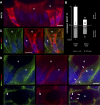
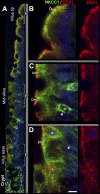

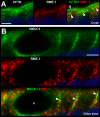
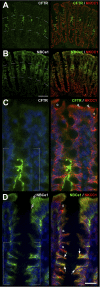

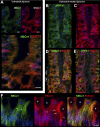

Similar articles
-
Cell-specific effects of luminal acid, bicarbonate, cAMP, and carbachol on transporter trafficking in the intestine.Am J Physiol Gastrointest Liver Physiol. 2012 Oct 15;303(8):G937-50. doi: 10.1152/ajpgi.00452.2011. Epub 2012 Aug 30. Am J Physiol Gastrointest Liver Physiol. 2012. PMID: 22936272 Free PMC article.
-
Lubiprostone targets prostanoid signaling and promotes ion transporter trafficking, mucus exocytosis, and contractility.Dig Dis Sci. 2012 Nov;57(11):2826-45. doi: 10.1007/s10620-012-2352-8. Epub 2012 Aug 25. Dig Dis Sci. 2012. PMID: 22923315 Free PMC article.
-
Characterization of CFTR High Expresser cells in the intestine.Am J Physiol Gastrointest Liver Physiol. 2013 Sep 15;305(6):G453-65. doi: 10.1152/ajpgi.00094.2013. Epub 2013 Jul 18. Am J Physiol Gastrointest Liver Physiol. 2013. PMID: 23868408 Free PMC article.
-
HCO3- transport in relation to mucus secretion from submucosal glands.JOP. 2001 Jul;2(4 Suppl):280-4. JOP. 2001. PMID: 11875272 Review.
-
IRBIT: a regulator of ion channels and ion transporters.Biochim Biophys Acta. 2014 Oct;1843(10):2195-204. doi: 10.1016/j.bbamcr.2014.01.031. Epub 2014 Feb 8. Biochim Biophys Acta. 2014. PMID: 24518248 Review.
Cited by
-
News in caecal signalling: the role of propionate in microbial-epithelial crosstalk.Pflugers Arch. 2021 Jun;473(6):853-854. doi: 10.1007/s00424-021-02579-2. Epub 2021 May 24. Pflugers Arch. 2021. PMID: 34028588 Free PMC article. No abstract available.
-
Clearance of small intestinal crypts involves goblet cell mucus secretion by intracellular granule rupture and enterocyte ion transport.Sci Signal. 2022 Sep 20;15(752):eabl5848. doi: 10.1126/scisignal.abl5848. Epub 2022 Sep 20. Sci Signal. 2022. PMID: 36126118 Free PMC article.
-
Bicarbonate secretion and acid/base sensing by the intestine.Pflugers Arch. 2024 Apr;476(4):593-610. doi: 10.1007/s00424-024-02914-3. Epub 2024 Feb 19. Pflugers Arch. 2024. PMID: 38374228 Free PMC article. Review.
-
Increased spinal cord Na⁺-K⁺-2Cl⁻ cotransporter-1 (NKCC1) activity contributes to impairment of synaptic inhibition in paclitaxel-induced neuropathic pain.J Biol Chem. 2014 Nov 7;289(45):31111-20. doi: 10.1074/jbc.M114.600320. Epub 2014 Sep 24. J Biol Chem. 2014. PMID: 25253692 Free PMC article.
-
The Contributions of Human Mini-Intestines to the Study of Intestinal Physiology and Pathophysiology.Annu Rev Physiol. 2017 Feb 10;79:291-312. doi: 10.1146/annurev-physiol-021115-105211. Annu Rev Physiol. 2017. PMID: 28192061 Free PMC article. Review.
References
-
- Ainsworth M, Koss MA, Hogan DL, Isenberg JI. Higher proximal duodenal mucosal bicarbonate secretion is independent of Brunner's glands in rats and rabbits. Gastroenterology 109: 1160–1166, 1995 - PubMed
-
- Allen A, Flemstrom G. Gastroduodenal mucus bicarbonate barrier: protection against acid and pepsin. Am J Physiol Cell Physiol 288: C1–C19, 2005 - PubMed
-
- Alper SL, Rossmann H, Wilhelm S, Stuart-Tilley AK, Shmukler BE, Seidler U. Expression of AE2 anion exchanger in mouse intestine. Am J Physiol Gastrointest Liver Physiol 277: G321–G332, 1999 - PubMed
-
- Ameen N, Alexis J, Salas P. Cellular localization of the cystic fibrosis transmembrane conductance regulator in mouse intestinal tract. Histochem Cell Biol 114: 69–75, 2000 - PubMed
-
- Ameen N, Apodaca G. Defective CFTR apical endocytosis and enterocyte brush border in myosin VI-deficient mice. Traffic 8: 998–1006, 2007 - PubMed
Publication types
MeSH terms
Substances
Grants and funding
LinkOut - more resources
Full Text Sources
Other Literature Sources

